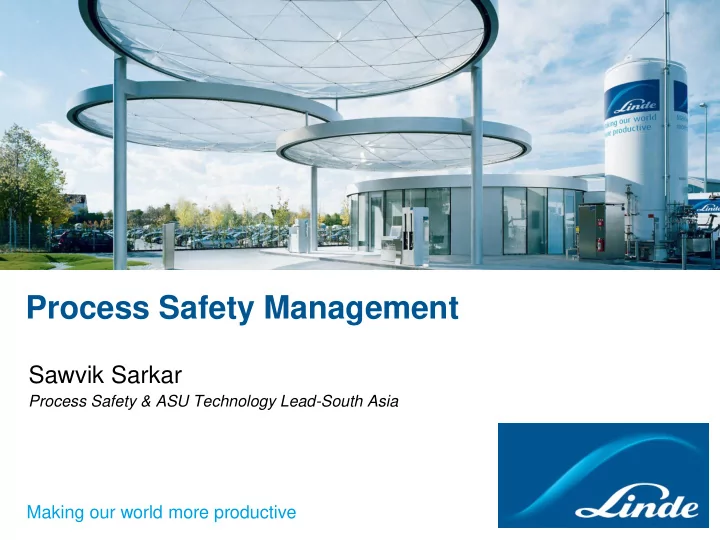

Process Safety Management Sawvik Sarkar Process Safety & ASU Technology Lead-South Asia Making our world more productive
What is Process Safety? A definition by Reynold Training Services You can further check @ https://youtu.be/i1pKYhFQJvM 2
Disasters in Industry Flixboroug What went wrong:- Fatality • Modifications made without proper risk assessment h • Operating practices were modified ~ 28 1974 What went wrong:- Bhopal Fatality • The storage refrigeration system was down • The high temperature alarm was disabled 1984 > 3000 • Scrubbing system was not available What went wrong:- Bintulu Fatality • Hydrocarbon contamination in Re-bolier • Low purge of liquid Oxygen 1997 Lucky !!! What went wrong:- BP Texas Fatality • Level transmitter malfunctioned • Operating practices were not followed • Location of temporary trailers very close to vent stack 2005 ~ 15 What went wrong:- Henan Fatality • Leakage in cold box leading to O2 enrichment in insulation • Operation continued despite of leakage & crack on cold 2019 ~ 15 box • Operating procedure not followed 8/15/2019 Footer 3
Root Cause & Learnings Flixboroug Root Cause:- Learning • No Engineering Management of Change h • Operating practices were not followed • Awareness & Evaluation of Hazards and Risks involved in day to day 1974 operations. Root Cause:- Bhopal • Lack of Engineering Management of Change • Review and Document Design and • Ineffective Emergency Preparedness and Community 1984 Operational Procedure changes. Notification • Inadequate Mechanical Integrity and Maintenance • Competency development, Training Bintulu Root Cause:- & Assessment. • Ineffective Employee training • Lack of Hazard Awareness • Develop & adherence to 1997 Maintenance schedules • Develop & adhere to Standard Root Cause:- BP Texas Operating Procedures. • Lack of Engineering Management of Change • • Develop Emergency Prepardness Inadequate Mechanical Integrity and Maintenance • 2005 Inadequate incident/near miss investigation process Root Cause:- Henan • Inadequate Hazard Awareness • Not following operating procedures 2019 8/15/2019 Footer 4
Risk Reduction ➢ Risk Reduction is the art of applying controls to reduce risk – No “Risk Control” is completely fail safe unless the hazard can be eliminated – Process controls must be selected according to their effectiveness – Generally, more than one layer of protection should be applied, particularly for major hazards or where the risk is high ➢ Control Hierarchy More Effective – Eliminate the hazard – Substitution or inventory reduction – Engineering controls (safety valves, process trips, interlocks, etc) – Isolation of the hazard (blast shields, barriers, insulation, etc) – Procedural or administrative controls (work instructions, training, signs, etc) – Personal Protective Equipment Least Effective – Accept the risk 15/08/2019 5 5
Control of process hazards - “ Layers of Protection ” x x Plant and Emergency response layer Emergency Response Mitigate Safety barrier Passive protection layer Bund Relief valve, Active protection layer Rupture disk Safety Emergency Safety layer Instrumented Shut Down System Prevent Trip level alarm Process Operator Process control layer Shutdown Intervention Process alarm Basic Process Process Process control layer Value Normal behaviour Control System 15/08/2019 6 6
What is an acceptable level of Risk? Organisations have a legal & moral responsibility to reduce risks ‘As Low As Reasonably Practical’ (ALARP) ALARP boundaries for individual risks: Typical values. Risk magnitude Intolerable region Risk cannot be justified or Severe (P1) Typically fatality risk is tolerated High (P2) higher than 10 -4 per year Tolerable only if further risk reduction is impracticable or if its cost is grossly The ALARP or Medium disproportionate to the improvement tolerability region gained (P3) (risk is undertaken Tolerable if cost of reduction would only if a benefit is desired) exceed the improvements gained Low It is necessary to maintain Broadly acceptable region assurance that risk remains at this Typically fatality risk is lower than 10 -6 per year level This principle applies to Design, Operation & Maintenance activities 15/08/2019 7 7
Process Safety Management system Elements • Wake up call for industry to improve Process Safety • Many systematic, organizational and technological failures identified which still remains as the underlying causes for the major incidents 1. Organisation and Personnel (Competency, Awareness, Culture & Practise) 2. Process and Material Information ( Threshold Quantities, Data sheets etc.) 3. Hazard Identification and Evaluation (Process Hazard Analysis, HAZOP, Risk Assessments) 4. Operational Control (Robust Procedures, Procedure Check & Compliance) 5. Safe Systems of Work (PPE, Risk Identification, Work Permit) 6. Mechanical Integrity and Reliability (Inspection, Maintenance, Re-validation, Calibration) 7. Competency development (Training & Assessment) 8. Engineering Management of Change (Risk Assessment & Documentation) 9. Pre Start-Up Safety Reviews (Look for hidden Hazards in changed situations) Emergency Planning and Response (Define Emergency Situations, DO’s & DON’Ts in emergency) 10. 11. Incident Handling (RCA, Tools and techniques, Communication - Lessons from Loss) Process Safety Performance (Define Process Safety KPIs – Reporting Targets) 12. Finally, Audit – Checks & Balances 15/08/2019 8 8
Ways to learn??????? ➢ Learning from accidents ??? : Pain / Fatalities / Injuries / Failures/Business Impact ➢ Learning from incidents ??? : Injuries / Cost / Failures / Business Impact ➢ Learning from others’ incidents : Free Learning for us, may not be for “others” ➢ Learning from near misses : Free Learning for us, may not be for “others” The most important way to learn is from “Sharing” Best Practices across industries. Many lives can be saved……… Stay Safe; Act Safe; Keep Safe – Make our world more productive 15/08/2019 9 9
Making our world more productive Thank you
Recommend
More recommend